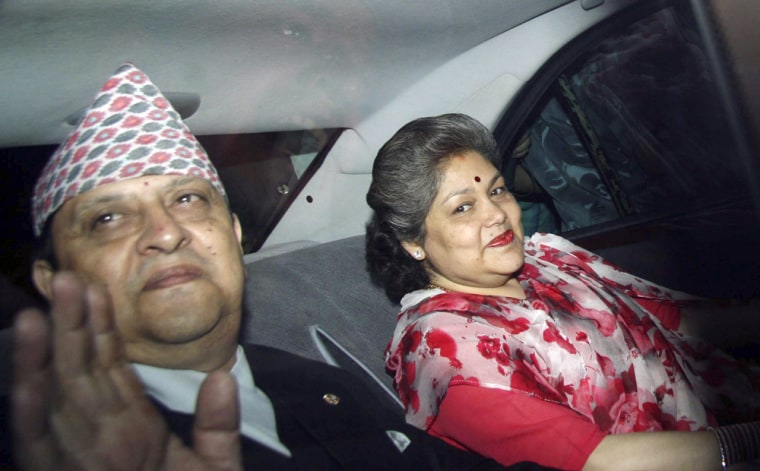Nepal's deposed king gave up his crown of peacock feathers, yak hair and jewels on Wednesday and left his palace forever.
Former King Gyanendra's departure closed the final chapter on the world's last Hindu monarchy, but a remnant stayed behind: the 94-year-old mistress of the deposed monarch's grandfather, who died more than a half-century ago.
Few Nepalis knew of the mysterious elderly woman's existence until authorities announced Wednesday that she would be allowed to continue living in the palace. The reason: the youngest mistress of King Tribhuwan, who ruled the Himalayan kingdom from 1911 until his death in 1955, has no house to move to or relatives to take her in.
Little else will remain, however, of a dynasty that united Nepal and reigned for 239 years. The palace — a pink concrete monstrosity — will be turned into a museum. But there's little likelihood it will celebrate a monarchy that Nepal's new government of former communist rebels fought to overthrow.
Deposed king to live like others
Gyanendra is to live as something akin to an ordinary citizen, albeit an incredibly wealthy one, protected by police at a one-time summer palace on a forested hill on the outskirts of Katmandu.
"I have no intention or thoughts to leave the country," Gyanendra said hours before departing, his first public comments in the months since it became apparent he was going to lose his crown. "I will stay in the country to help establish peace."
The vast majority of Nepalis have made it clear they are pleased to see the monarchy end. While Gyanendra's throne was formally abolished last month, his departure Wednesday carries great significance in a nation ruled by Shah dynasty monarchs for more than two centuries.
The former king and his wife pulled out of the palace gates in an armored black Mercedes at about 8:45 p.m., followed by a police and army escort. A few loyalist onlookers shouted for Gyanendra to stay on the throne, but most of the several hundred people gathered were happy to see him go.
"I came to see the end of a dark era," said Gopal Shakya, a shopkeeper in Katmandu who watched the king leave the palace. "Tomorrow it will be a brand new beginning for Nepal."
Nepal was declared a republic last month after elections that saw the country's former communist rebels win the most seats in a special assembly charged with rewriting the constitution.
"I have accepted the decision," Gyanendra told reporters gathered Wednesday in a grand palace hall decorated with portraits of the Shah dynasty kings, stuffed tigers and ornate chandeliers. "I have done all I can to cooperate with their directives."
Palace became home after massacre
The Narayanhiti palace has been Gyanendra's home since he became king in 2001 after a massacre in which a gunman, allegedly the crown prince, assassinated his brother, King Birendra, and much of the royal family before killing himself.
After his brother's death, Gyanendra assumed the throne. But the killings helped pierce the mystique surrounding a line of kings once revered as reincarnations of the Hindu god Vishnu.
No proof has ever surfaced that Gyanendra was involved in the massacre, but rumors have swirled for years that he was behind the slaughter.
On Wednesday, he dismissed the accusations as a baseless "campaign to defame the royal institution."
In 2005, Gyanendra seized power from a civilian government, a move that made him deeply unpopular. He said he needed total authority to crush a communist insurgency. But the rebellion intensified, and a year later massive protests forced Gyanendra to restore democracy. Soon after, the rebels began peace talks that ended their 10-year-old insurgency, in which some 13,000 people were killed.
The king does not leave public life a pauper, even if his palaces have been nationalized and his $3.1 million annual allowance cut.
Before assuming the throne, he was known as a tough businessman with interests in tourism, tea and tobacco. He also inherited much of his family's wealth after the palace massacre.
The government is letting Gyanendra live in the summer palace — which was among the nationalized royal residences — because the former king's son is living in the family's private Katmandu residence.
As for the former mistress, Sarala Gorkhali, she and Gyanendra's 80-year-old stepmother are being allowed to remain at the main palace because they own no property and have nowhere else to go, said interim Home Minister Krishna Prasad Sitaula.
Gorkhali was virtually unknown in Nepal until Wednesday, when authorities announced she would be allowed to continue living in two buildings on the palace grounds.
And on Wednesday, she had an inside view of the Shah dynasty's final act — Gyanendra's departure from the palace and public life.
